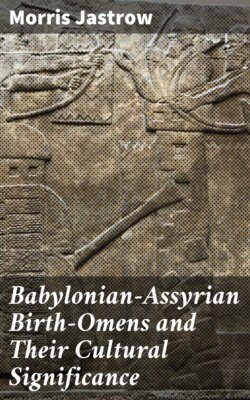Читать книгу Babylonian-Assyrian Birth-Omens and Their Cultural Significance - Morris Jastrow - Страница 3
На сайте Литреса книга снята с продажи.
I
ОглавлениеTable of Contents
As a result of researches in the field of Babylonian-Assyrian divination, now extending over a number of years[1], it may be definitely said that apart from the large class of miscellaneous omens[2], the Babylonians and Assyrians developed chiefly three methods of divination into more or less elaborate systems—divination through the inspection of the liver of a sacrificial animal or Hepatoscopy, through the observation of the movements in the heavens or Astrology, (chiefly directed to the moon and the planets but also to the sun and the prominent stars and constellations), and through the observance of signs noted at birth in infants and the young of animals or Birth-omens. Elsewhere[3], I have suggested a general division of the various forms of divination methods into two classes, voluntary and involuntary divination, meaning by the former the case in which a sign is deliberately selected and then observed, by the latter where the sign is not of your own choice but forced upon your attention and calling for an interpretation. Hepatoscopy falls within the former category[4], Astrology and Birth-omens in the latter.
Each one of these three methods rests on an underlying well-defined theory and is not the outcome of mere caprice or pure fancy, though of course these two factors are also prominent. In the case of Hepatoscopy, we find the underlying theory to have been the identification of the ‘soul’ or vital centre of the sacrificial victim—always a sheep—with the deity to whom the animal is offered,—at least to the extent that the two souls are attuned to one another. The liver being, according to the view prevalent among Babylonians and Assyrians as among other peoples of antiquity at a certain stage of culture, the seat of the soul[5], the inspection of the liver followed as the natural and obvious means of ascertaining the mind, i. e., the will and disposition of the deity to whom an inquiry has been put or whom one desired to consult. The signs on the liver—the size and shape of the lobes, and of the gall bladder, the character or peculiarities of the two appendices to the upper lobe, (the processus pyramidalis and the processus papillaris), and the various markings on the liver were noted, and on the basis of the two main principles conditioning all forms of divination (1) association of ideas and (2) noting the events that followed upon certain signs, a decision was reached as to whether the deity was favorably or unfavorably disposed or, what amounted to the same thing, whether the answer to the inquiry was favorable or unfavorable.
In the case of Astrology,—a relatively more advanced method of divination,—the underlying theory rested on the supposed complete correspondence between movements and phenomena in the heavens and occurrences on earth. The gods, being identified with the heavenly bodies,—with the moon, sun, planets, and fixed stars—or as we might also put it, the heavenly bodies being personified as gods, the movements in the heavens were interpreted as representing the activity of the gods preparing the events on earth. Therefore, he who could read the signs in the heavens aright would know what was to happen here below. Astrology corresponded in a measure to the modern Weather Bureau in that it enabled one to ascertain a little in advance what was certain to happen, sufficiently so in order to be prepared for it. Compared with Hepatoscopy, Astrology not only represents a form of divination that might be designated as semi-scientific—only relatively scientific of course—but also occupies a higher plane, because there was no attempt involved to induce a deity unfavorably disposed to change his mind. The signs were there; they pointed unmistakably to certain occurrences on earth that were certain to occur and it was the task of the diviner—the bârû or ‘inspector’ as the Babylonian called him—to indicate whether what the gods were preparing would be beneficial or harmful. Both Hepatoscopy and Astrology as developed by the Babylonians and Assyrians bârû-priests exerted a wide influence, the former spreading to the Hittites and Etruscans and through the one or the other medium to Greeks and Romans[6], while Babylonian-Assyrian Astrology passing to the Greeks became the basis for Graeco-Roman and mediaeval Astrology, profoundly influencing the religious thought of Europe[7] and in a modified form surviving even to our own days. The chain of evidence has recently been completed[8] to prove the direct transfer of the cuneiform astrological literature to Greek astrologers and astronomers. The possibility also of a spread or at least of a secondary influence of both systems to the distant East is also to be considered. In fact considerable evidence is now available to show that Babylonian-Assyrian astrological notions and in part also astronomical data spread to China[9].
